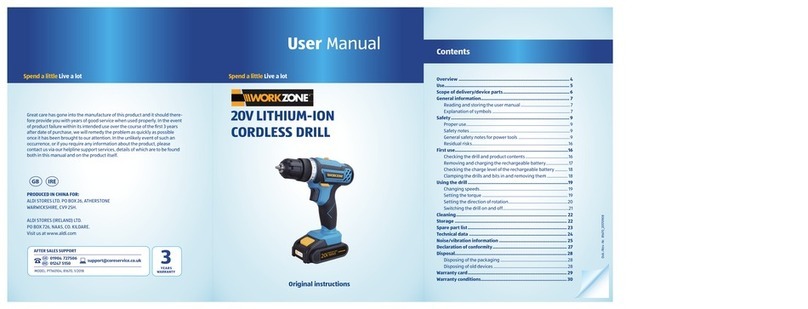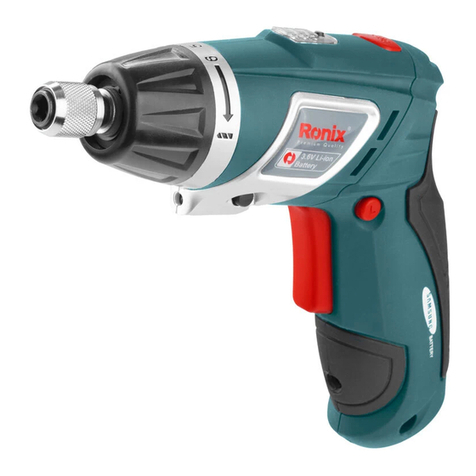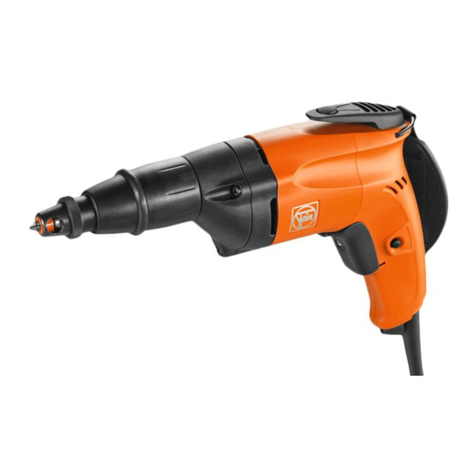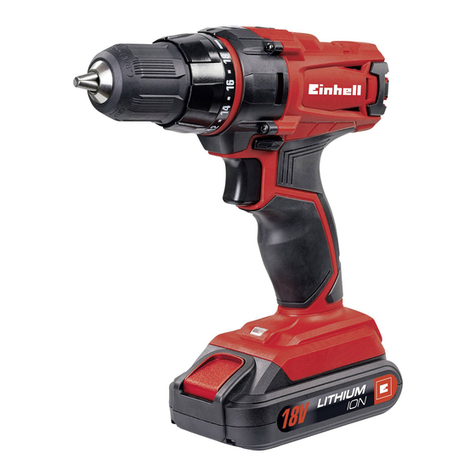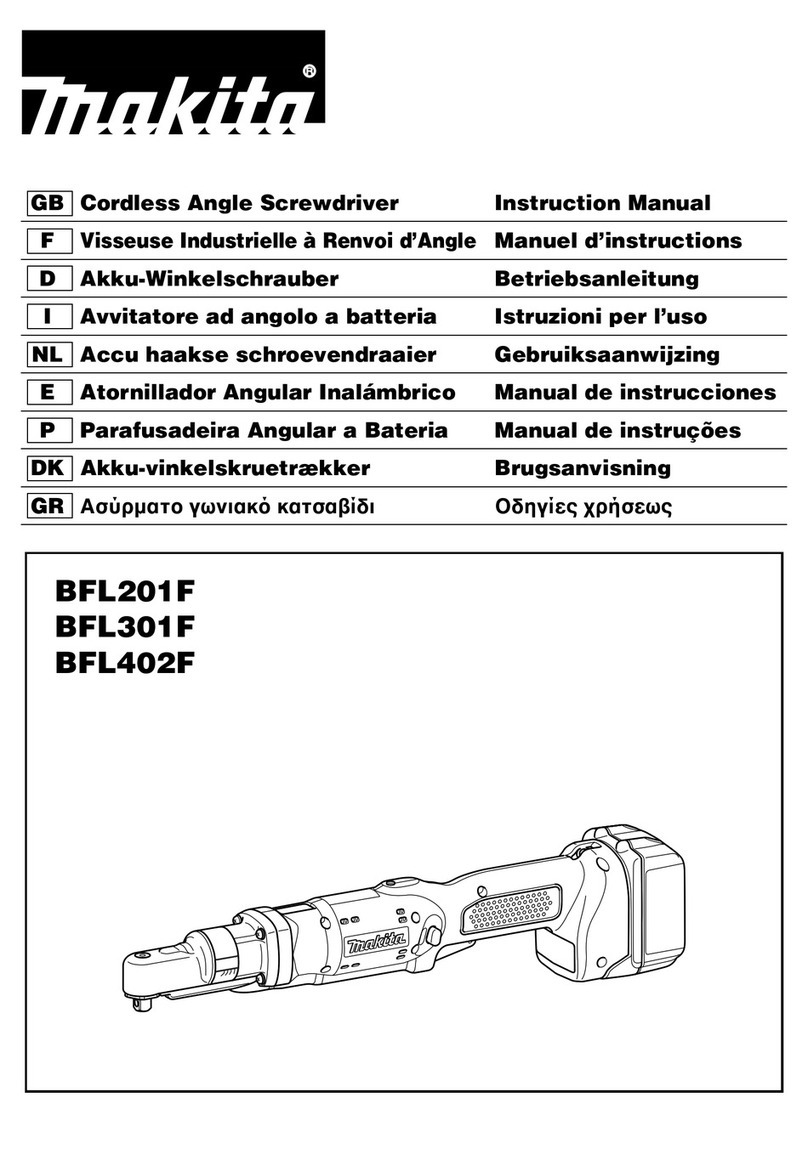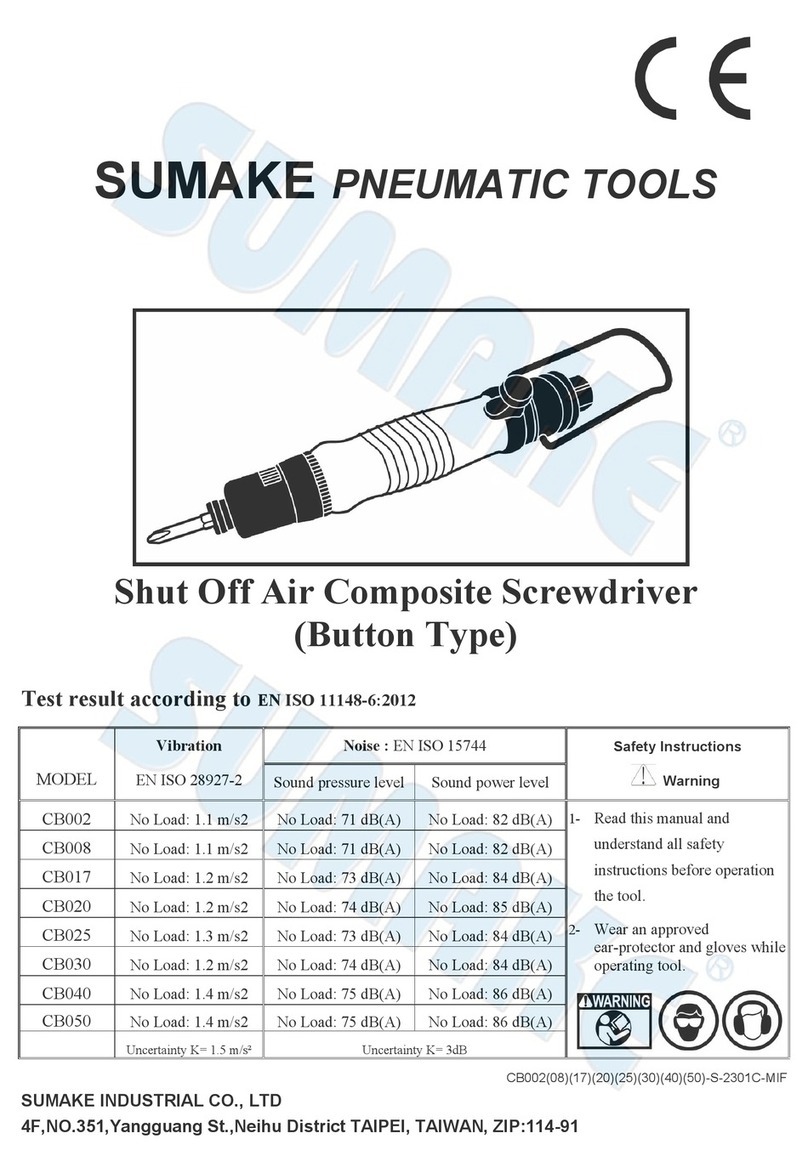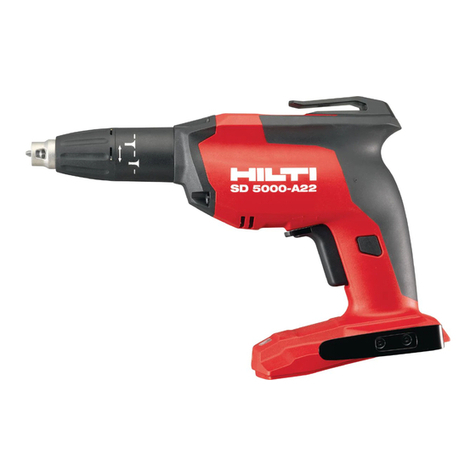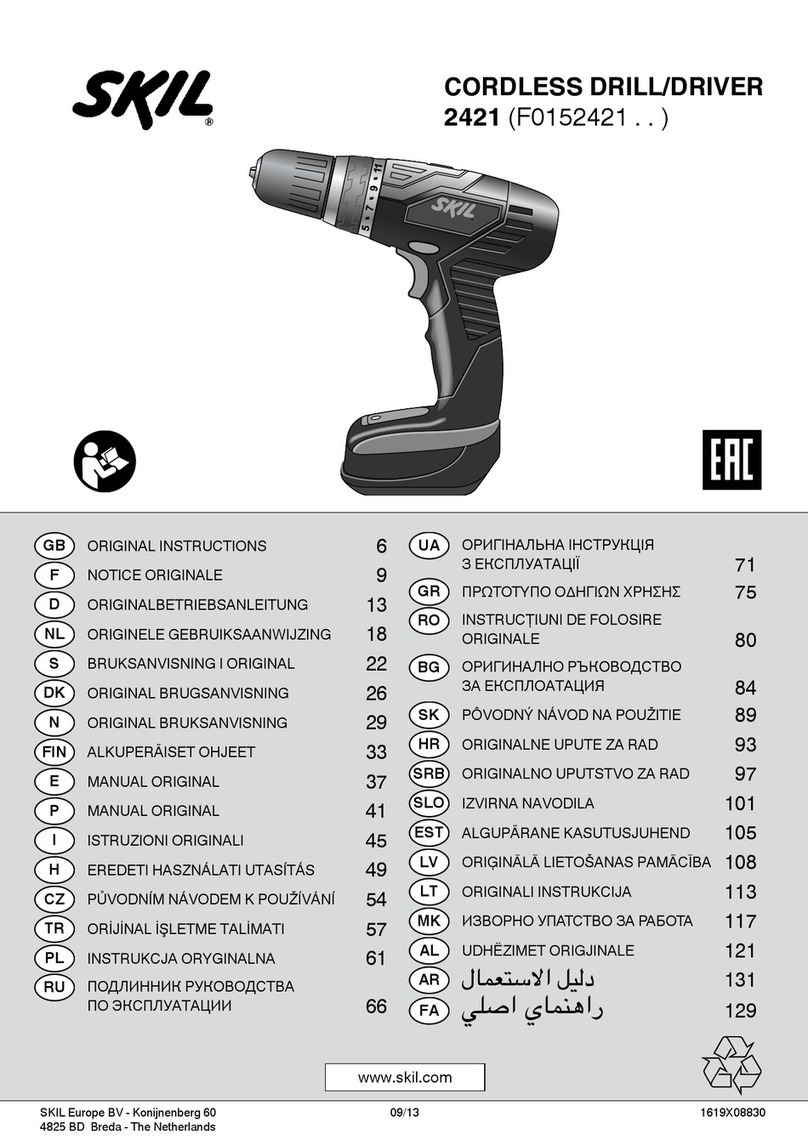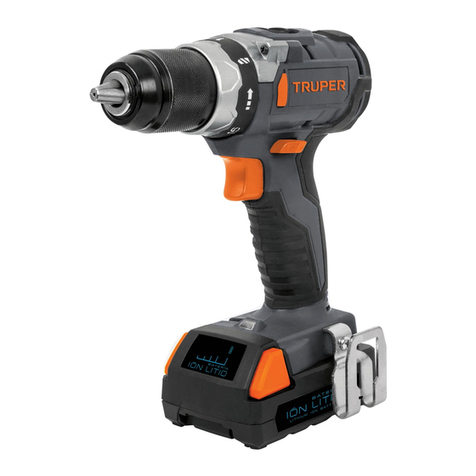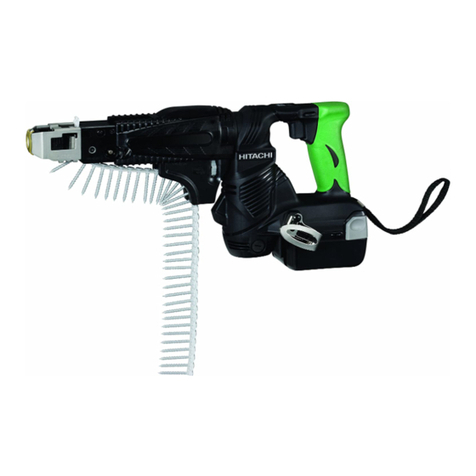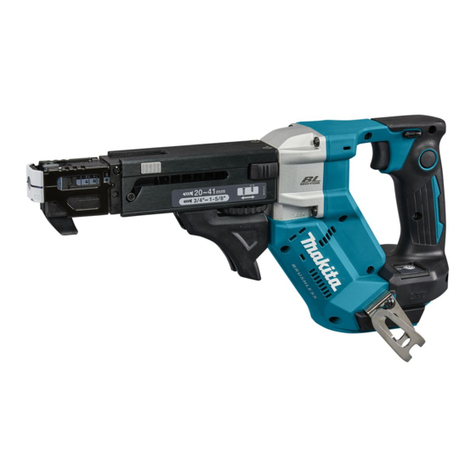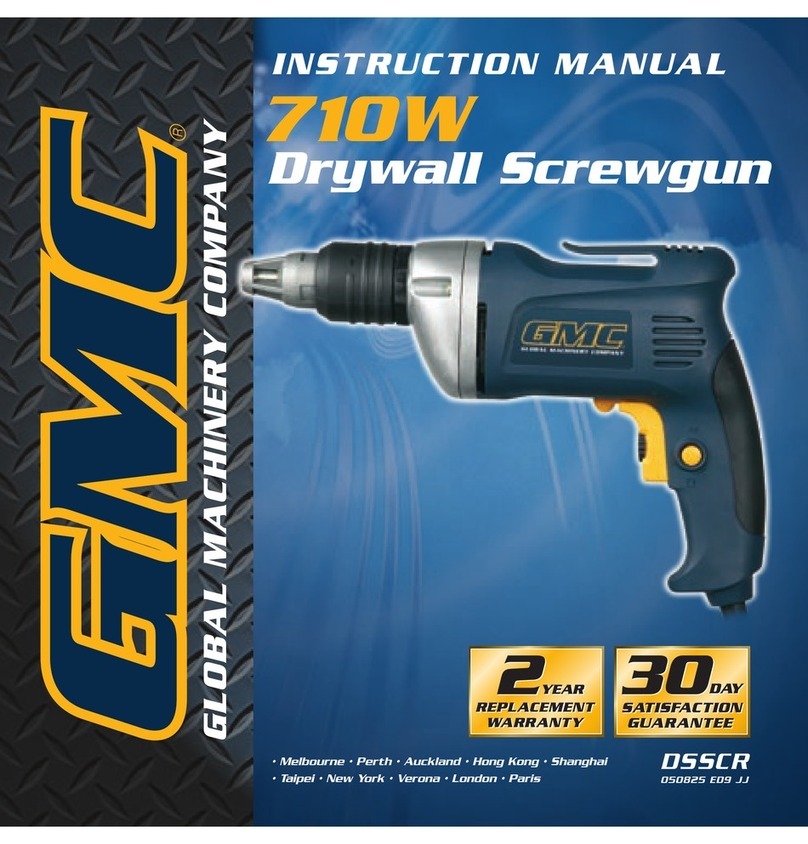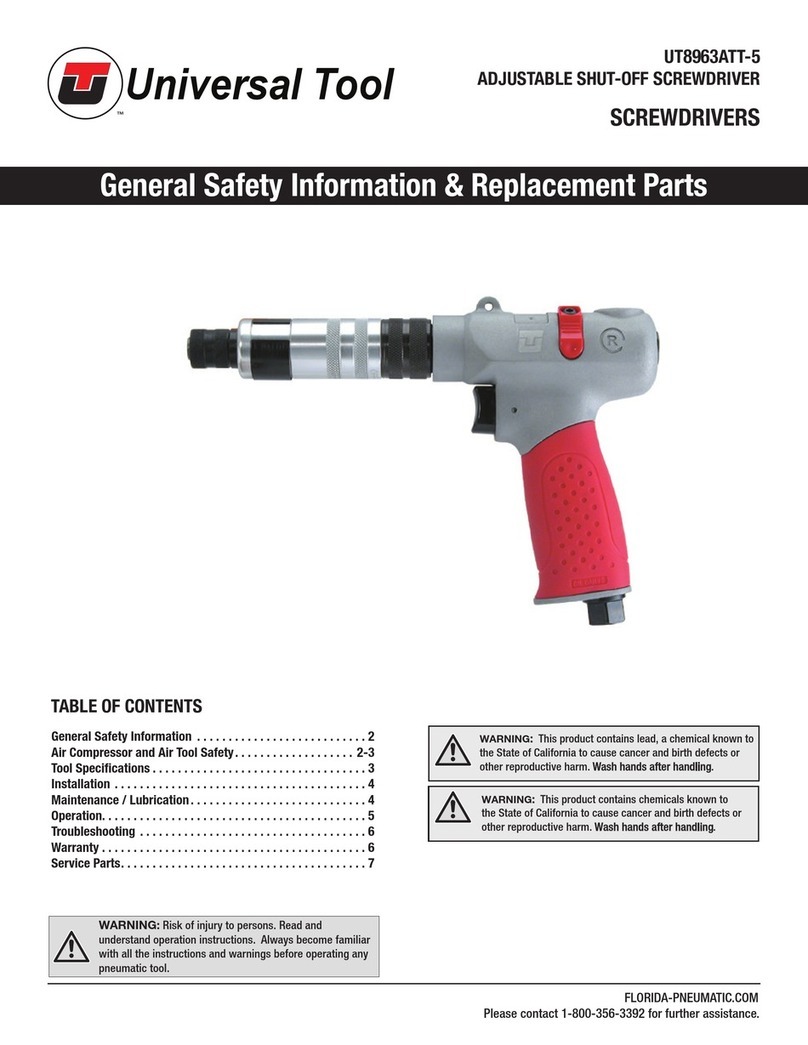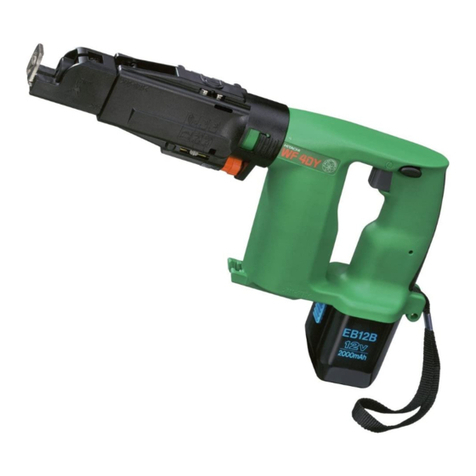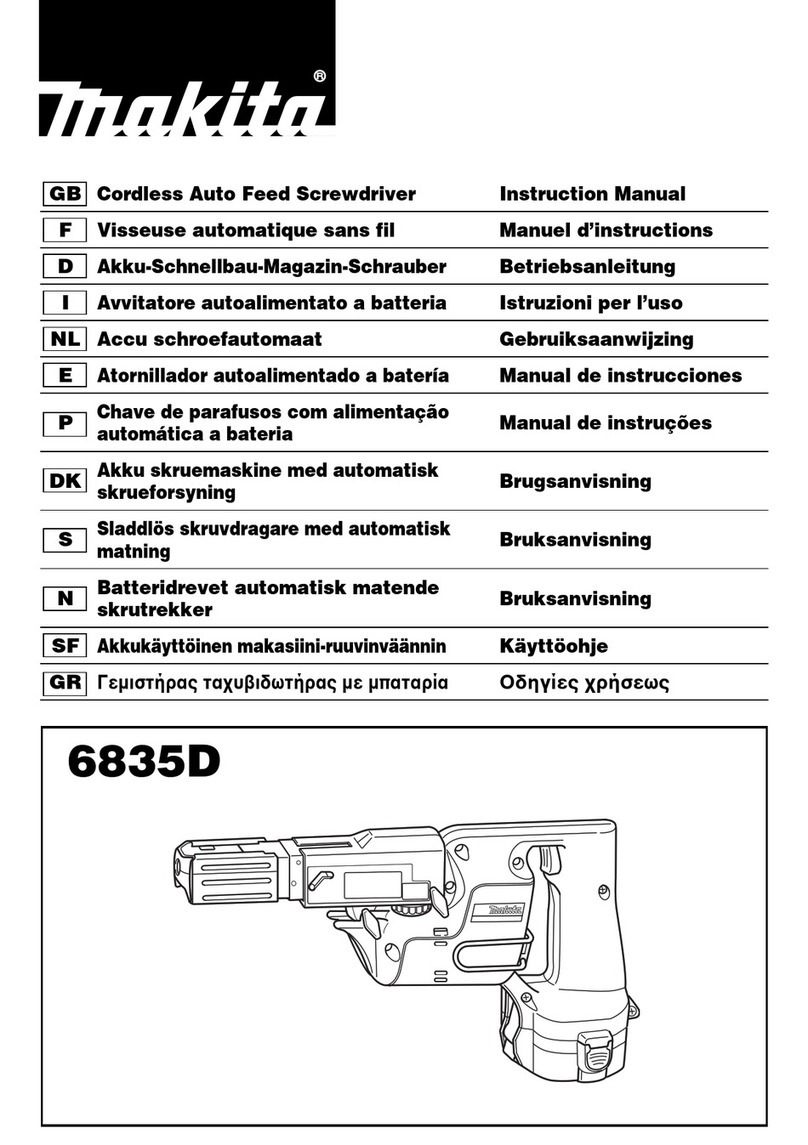Toolshop 241-9931 User manual

4.5 Amp. DRYWALL SCREWDRIVER
241-9931
Owner’s Manual
PRODUCT SPECIFICATIONS
Rating:
120 V, 60 Hz AC
Amperes:
4.5 Amp.
Speed:
0–4,500 RPM (no load)
Weight:
3 lb 3 oz (1.45 kg)
Need Assistance?
Call us on our toll free customer support line:
1-866-349-8665
Technical questions
Replacement parts
Parts missing from package
Distributed by: Menard, Inc., Eau Claire, WI 54703

2
Product specifications ………….…………………………………………………….
1
Table of contents ……………………………………………………………………...
2
General safety warnings ……………………………………………………………..
3–4
Eye, ear & lung protection ……………………………………………………………
3–4
Electrical safety ……………………………………………………………………….
4
Power tool safety ……………………………………………………………………...
5–6
General safety warnings ……………………………………………………………..
5
Work area safety ………………………………………………………….…………..
5
Electrical safety ……………………………………………………………………….
5
Personal safety ………………………………………………………………………..
5–6
Power tool use and care …....………………………………………………………..
6
Service …………………………………………………………………………………
6
Specific safety rules …………………………………………………………………..
7
Extension cord safety ………………………………………………………………...
8
Symbols ………………………………………………………………………………..
9
Know your drywall screwdriver ………………………………………………………
10
Accessories ……………………………………………………………………………
10
Contents ……………………………………………………………………………….
11
Assembly and operating ……………………………………………………………..
12–18
Forward/reverse switch ………………………………………………………………
12
Trigger switch lock ……………………………………………………………………
12–13
Inserting a screwdriver bit ……………………………………………………………
13
Replacing the magnetic bit holder …………………………………………………..
14
Adjusting the screw driving depth …………………………………………………...
15–17
Tips for driving drywall screws ………………………………………………………
17
Removing drywall screws ……………………………………………………………
18
Maintenance …………………………………………………………………………..
19
Exploded view …………………………………………………………………………
20
Parts list ………………………………………………………………………………..
21–22
Warranty ……………………………………………………………………….………
23
TABLE OF CONTENTS

3
EYE, EAR & LUNG PROTECTION
This instruction manual includes the following:
General Safety Rules
Specific Safety Rules and Symbols
Functional Description
Assembly
Operation
Maintenance
Accessories
!
ALWAYS WEAR EYE PROTECTION THAT CONFORMS WITH CSA
REQUIREMENTS or ANSI SAFETY STANDARD Z87.1
FLYING DEBRIS can cause permanent eye damage. Prescription
eyeglasses ARE NOT a replacement for proper eye protection.
WARNING: Non-compliant eyewear can cause serious injury if
broken during the operation of a power tool.
SAVE THESE INSTRUCTIONS FOR REFERENCE
WARNING: Use hearing protection, particularly during extended
periods of operation of the tool, or if the operation is noisy.
!
GENERAL SAFETY WARNINGS
WARNING: Before using this tool or any of its accessories, read this
manual and follow all Safety Rules and Operating Instructions. The important
precautions, safeguards and instructions appearing in this manual are not
meant to cover all possible situations. It must be understood that common
sense and caution are factors which cannot be built into the product.
!

4
ELECTRICAL SAFETY
WARNING: To avoid electrical hazards, fire hazards or damage to the
tool, use proper circuit protection.
This tool is wired at the factory for 120 V AC operation. It must be
connected to a 120 V AC, 15 A circuit that is protected by a time-delayed
fuse or circuit breaker. To avoid shock or fire, replace power cord
immediately if it is worn, cut or damaged in any way.
GENERAL SAFETY WARNINGS
WEAR A DUST MASK THAT IS DESIGNED TO BE USED WHEN
OPERATING A POWER TOOL IN A DUSTY ENVIRONMENT.
WARNING: Dust that is created by power sanding, sawing, grinding,
drilling, and other construction activities may contain chemicals that are
known to cause cancer, birth defects, or other genetic abnormalities. These
chemicals include:
Lead from lead-based paints
Crystalline silica from bricks, cement, and other masonry products
Arsenic and chromium from chemically treated lumber
The level of risk from exposure to these chemicals varies, according to how
often this type of work is performed. In order to reduce exposure to these
chemicals, work in a well-ventilated area, and use approved safety
equipment, such as a dust mask that is specifically designed to filter out
microscopic particles.
!

5
WARNING: Read all safety warnings
and instructions. Failure to follow the
warnings and instructions may result in
electric shock, fire and/or serious injury.
Save all warnings and instructions for
future reference.
Work area safety
Keep work area clean and well lit.
Cluttered or dark areas invite accidents.
Do not operate power tools in explosive
atmospheres, such as in the presence
of flammable liquids, gases or dust.
Power tools create sparks which may
ignite the dust or fumes.
Keep children and bystanders away
while operating a power tool.
Distractions can cause you to lose control.
Electrical safety
Power tool plugs must match the outlet.
Never modify the plug in any way. Do
not use any adapter plugs with earthed
(grounded) power tools. Unmodified
plugs and matching outlets will reduce risk
of electric shock.
Avoid body contact with earthed or
grounded surfaces such as pipes,
radiators, ranges and refrigerators.
There is an increased risk of electric shock
if your body is earthed or grounded.
Do not expose power tools to rain or
wet conditions. Water entering a power
tool will increase the risk of electric shock.
Do not abuse the cord. Never use the
cord for carrying, pulling or unplugging
the power tool. Keep cord away from
heat, oil, sharp edges or moving parts.
Damaged or entangled cords increase the
risk of electric shock.
When operating a power tool outdoors,
use an extension cord suitable for
outdoor use. Use of a cord suitable for
outdoor use reduces the risk of electric
shock.
If operating a power tool in a damp
location is unavoidable, use a residual
current device (RCD) protected supply.
Use of a ground fault circuit interrupter
(GFCI) reduces the risk of electric shock.
Personal safety
Stay alert, watch what you are doing
and use common sense when operating
a power tool. Do not use a power tool
while you are tired or under the
influence of drugs, alcohol or
medication. A moment of inattention while
operating power tools may result in serious
personal injury.
Use personal protective equipment.
Always wear eye protection. Protective
equipment such as dust mask, non-skid
safety shoes, hard hat, or hearing
protection used for appropriate conditions
will reduce personal injuries.
Prevent unintentional starting. Ensure
the switch is in the off-position before
connecting to power source and/or
battery pack, picking up or carrying the
tool. Carrying power tools with your finger
on the switch or energising power tools
that have the switch on invites accidents.
POWER TOOL SAFETY
!

6
PERSONAL SAFETY –cont’d
Remove any adjusting key or wrench
before turning the power tool on. A
wrench or a key left attached to a rotating
part of the power tool may result in
personal injury.
Do not overreach. Keep proper footing
and balance at all times. This enables
better control of the power tool in
unexpected situations.
Dress properly. Do not wear loose
clothing or jewellery. Keep your hair,
clothing and gloves away from moving
parts. Loose clothes, jewellery or long hair
can be caught in moving parts.
If devices are provided for the
connection of dust extraction and
collection facilities, ensure these are
connected and properly used. Use of
dust collection can reduce dust-related
hazards.
Power tool use and care
Do not force the power tool. Use the
correct power tool for your application.
The correct power tool will do the job
better and safer at the rate for which it was
designed.
Do not use the power tool if the switch
does not turn it on and off. Any power
tool that cannot be controlled with the
switch is dangerous and must be repaired.
Disconnect the plug from the power
source and/or the battery pack from the
power tool before making any
adjustments, changing accessories, or
storing power tools. Such preventive
safety measures reduce the risk of starting
the power tool accidentally.
Store idle power tools out of the reach
of children and do not allow persons
unfamiliar with the power tool or these
instructions to operate the power tool.
Power tools are dangerous in the hands of
untrained users.
Maintain power tools. Check for
misalignment or binding of moving
parts, breakage of parts and any other
condition that may affect the power
tool’s operation. If damaged, have the
power tool repaired before use. Many
accidents are caused by poorly maintained
power tools.
Keep cutting tools sharp and clean.
Properly maintained cutting tools with
sharp cutting edges are less likely to bind
and are easier to control.
Use the power tool, accessories and
tool bits etc. in accordance with these
instructions, taking into account the
working conditions and the work to be
performed. Use of the power tool for
operations different from those intended
could result in a hazardous situation.
Hold power tool by insulated grippng
surfaces, when performing an operation
where the fastener may contact hidden
wiring or its own cord. Fasteners
contacting a "live" wire may make exposed
metal parts of the power tool "live" and
could give the operator an electric shock.
Service
Have your power tool serviced by a
qualified repair person using only identical
replacement parts. This will ensure that the
safety of the power tool is maintained.
POWER TOOL SAFETY

7
WARNING: Know your drywall
screwdriver. Do not plug the tool into
the power source until you have read
and understand this Instruction Manual.
Learn the tool’s applications and
limitations, as well as the specific
potential hazards related to this tool.
Following this rule will reduce the risk of
electric shock, fire, or serious injury.
Always wear eye protection.
Any power tool can throw
foreign objects into your eyes
and cause permanent eye
damage. ALWAYS wear safety goggles
(not glasses) that comply with ANSI safety
standard Z87.1. Everyday glasses have
only impact resistant lenses. They ARE
NOT safety glasses.
WARNING: Glasses or goggles
not in compliance with ANSI Z87.1
could cause serious injury when they
break.
Never use the drywall screwdriver to drive
screws other than drywall screws. The
drywall screwdriver and the screwdriver
bits are designed specifically for driving
drywall screws.
Only use screwdriver bits that are
designed for use with this tool.
Always keep hands out of the path of the
drywall screw. Avoid awkward hand
positions where a sudden slip could cause
your hand to move into the path of the saw
blade.
Make sure there are no nails or foreign
objects in the part of the workpiece to be
cut or sanded.
To avoid injury from accidental starting,
always remove the plug from the power
source before installing or removing a
screwdriver bit or when adjusting the depth
control.
Always check the wall area where screws
will be driven to be sure there are no
hidden electrical wires in the area.
Never leave the trigger lock ON. Before
plugging the tool into the power source,
make sure the trigger lock is OFF.
SPECIFIC SAFETY RULES
!
SAVE THESE INSTRUCTIONS FOR REFERENCE
!

8
WARNING: Keep the extension
cord clear of the working area. Position
the cord so it will not get caught on the
workpiece, tools or any other obstructions
while you are working with the power tool.
Make sure any extension cord used with
this tool is in good condition. When using
an extension cord, be sure to use one of
heavy enough gauge to carry the current
the tool will draw. An undersized cord will
cause a drop in line voltage resulting in
loss of power and overheating.
The table at right shows the correct size to
use according to cord length and
nameplate ampere rating. If in doubt, use
the next heavier gauge. The smaller the
gauge number the heavier the cord.
Be sure your extension cord is properly
wired and in good condition. Always
replace a damaged extension cord or have
it repaired by a qualified electrician before
using it. Protect your extension cord from
sharp objects, excessive heat and damp or
wet areas.
Use a separate electrical circuit for your
power tools. This circuit must not be less
than 14 gauge wire and should be
protected with either a 15 A time delayed
fuse or circuit breaker. Before connecting
the power tool to the power source, make
sure the switch is in the OFF position and
the power source is the same as indicated
on the nameplate. Running at lower
voltage will damage the motor.
!
MINIMUM GAUGE (AWG)
EXTENSION CORDS (120 V use only)
Amperage
rating
Total length
More
than
Not
more
than
25'
(7.5 m)
50'
(15 m)
100'
(30 m)
150'
(45 m)
0
6
18
16
16
14
6
10
18
16
14
12
10
12
16
16
14
12
12
16
14
12
Not Applicable
EXTENSION CORD SAFETY

9
This symbol designates that this tool is
listed with U.S. requirements by
Underwriters Laboratories.
Conforms to UL Std. 60745-1, 60745-2-2.
3042597
JD2015U
LISTED
V
Volts
A
Amperes
Hz
Hertz
W
Watts
kW
Kilowatts
Microfarads
L
Litres
kg
Kilograms
H
Hours
N/cm2
Newtons per square
centimetre
Pa
Pascals
Min
Minutes
S
Seconds
or a.c.
Alternating current
Three-phase alternating
current
Three-phase alternating
current with neutral
Direct current
No load speed
Alternating or direct
current
Class II construction
Splash-proof
construction
Watertight construction
Protective grounding at
grounding terminal,
Class I tools
Revolutions or
reciprocations per
minute
Diameter
Off position
Arrow
Warning symbol
Wear your safety
glasses
SYMBOLS
WARNING: Some of the following symbols may appear on the drywall
screwdriver. Study these symbols and learn their meaning. Proper
interpretation of these symbols will allow for more efficient and safer
operation of this tool.
!

10
AVAILABLE ACCESSORIES
WARNING: Use only accessories
that are recommended for this drywall
screwdriver. Follow the instructions
that accompany the accessories. The
use of improper accessories may result
in injury to the operator or damage to
the tool.
Before using any accessory, carefully read
the instructions or the owner’s manual for
the accessory.
Drywall screwdriver bits
WARNING: If any part is missing or
damaged, do not plug the tool into the
power source or install any accessory until
the missing or damaged part is replaced.
KNOW YOUR DRYWALL SCREWDRIVER
ACCESSORIES
!
!
Variable speed
trigger switch
Lock-on
button
Forward/reverse
switch
Depth
adjustment
sleeve
Depth
stop
Belt clip

11
CONTENTS
Carefully unpack the drywall screwdriver.
Compare the contents against the
“DRYWALL SCREWDRIVER
COMPONENTS” chart below.
NOTE: See illustration of the drywall
screwdriver at right.
WARNING: To avoid fire or toxic
reaction, never use gasoline, naphtha,
acetone, lacquer thinner or similar
highly volatile solvents to clean the
tool.
CONTENTS
DRYWALL SCREWDRIVER
COMPONENTS
KEY
DESCRIPTION
QTY
A
Drywall screwdriver
1
Owner’s Manual
1
!

12
FORWARD/REVERSE SWITCH
The forward/reverse switch (1) is
conveniently mounted in front of the trigger
switch (2) (Fig. 1). To make the
screwdriver rotate clockwise for driving
screws, push the forward/reverse switch to
the left. To make the screwdriver rotate
counter-clockwise to remove screws, push
the forward/reverse switch to the right.
NOTES:
a) Never change the position of the
forward/reverse switch while the
screwdriver bit is turning.
b) The trigger switch will NOT function with
the forward/reverse switch in the middle
position.
VARIABLE-SPEED TRIGGER SWITCH
This screwdriver is equipped with a
variable-speed ON/OFF trigger switch.
1. To start screwdriver, gently squeeze
the trigger switch (2) (Fig. 2).
NOTE: The screwdriver will turn at its
slowest speed when the trigger switch is
depressed slightly. The screwdriver will
turn at its fastest speed when the trigger
switch is fully depressed.
2. To stop the screwdriver, release the
trigger switch.
TRIGGER SWITCH LOCK
The trigger switch lock-on feature allows
the trigger switch to be locked in the ON
position at full speed when continuous
operation for extended periods of time is
required.
ASSEMBLY AND OPERATINGASSEMBLY AND OPERATING
Fig. 1
Fig. 2

13
TRIGGER SWITCH LOCK –cont’d
To lock the trigger switch in the ON
position, pull back on the trigger switch (2)
to start the screwdriver and push the
trigger switch lock button (3) into the
screwdriver handle (Fig. 3). Release the
trigger switch while holding the trigger
switch lock button into the screwdriver
handle. The screwdriver will continue to
run. To release the trigger switch lock
button, pull trigger switch back and then
release the trigger.
NOTE: Operating the screwdriver with the
trigger switch ON for an extended period of
time may cause the screwdriver motor to
overheat. If the screwdriver gets hot, stop
driving screws and allow it to cool for at
least 15 minutes.
INSERTING A SCREWDRIVER BIT
This tool has a magnetic bit holder that
provides convenient bit changes. To install
a bit, simply insert the hex bit shank (1)
into the bit holder (2) that is located inside
the depth stop (3) (Fig. 4). Push the bit into
the bit holder until the magnet holds the bit
in place.
NOTES:
a) Use only 1" (25 mm) long bits that are
designed for use in driving drywall
screws.
b) Make sure the bit size is correct for
the drywall screws being driven. This
will usually be a #2 size.
ASSEMBLY AND OPERATING
Fig. 4
Fig. 3

14
REPLACING THE MAGNETIC BIT
HOLDER
If the magnetic bit holder becomes worn or
damaged, it must be replaced. The
replacement bit holder must be of the
same dimensions as the original and have
the ANSI retention groove on the end that
is inserted into the tool.
1. Remove the nosepiece (1) by turning
it counter clockwise (Fig. 5).
NOTE: Do not use pliers on the nosepiece.
Only use your hand.
2. Grasp the screwdriver bit (2) with
pliers and pull it out of the bit holder
(3).
3. Grasp the large end of the bit holder
with pliers and pull it straight out of the
screwdriver spindle (4).
4. Reverse the process by inserting the
replacement bit holder into the tool.
NOTE: When inserting the replacement bit
holder, gently tap it into place to make sure
it is fully inserted. Grasp the large end of
the bit holder to ensure the retention
groove (5) is holding the bit holder in place
in the tool.
5. Reinstall the screwdriver bit and nose
piece.
ASSEMBLY AND OPERATING
Fig. 5

15
ADJUSTING THE SCREW DRIVING
DEPTH
It is important to control the depth to which
the drywall screw will be driven. Over
driving the screw will drive the screw too
deep and break the outer paper layer of
the drywall. Under driving the screw will
leave the screw head above the drywall
surface making it impossible to properly
finish the drywall.
ASSEMBLY AND OPERATING
For safety reasons, the operator must
read the sections of this Owner’s
Manual entitled "GENERAL SAFETY
WARNINGS", "POWER TOOL
SAFETY", "SPECIFIC SAFETY RULES",
"EXTENSION CORD SAFETY" and
"SYMBOLS" before using this
screwdriver.
Verify the following every time the
screwdriver is used:
1. Safety glasses, safety goggles, or
face shield are being worn.
2. Hearing protection is being worn.
3. The screwdriver bit is the correct
size and is in good condition.
4. There are no potentially "live"
electrical wires where screws are
being driven.
Failure to observe these safety rules
will significantly increase the risk of
injury.
WARNING
!

16
ASSEMBLY AND OPERATING
ADJUSTING THE SCREW DRIVING DEPTH –
cont’d
The depth control system is made up of
the depth stop (1) and the depth
adjustment sleeve (2) (Fig. 6).
NOTE: The following adjustments should
always be verified using a scrap piece of
drywall to avoid damaging the "good"
drywall sections.
1. Rotate the depth adjustment sleeve
counter clockwise until approximately
1/4" of the screwdriver bit extends
beyond the depth stop.
2. Place a drywall screw onto the
screwdriver bit. The magnetized bit
will hold the screw onto the bit.
NOTE: Before driving the screw, press the
screw point into the drywall and make sure
the screw is perpendicular to the drywall.
3. Press the screw against the drywall
with steady even pressure and
squeeze the trigger switch. The clutch
in the tool will engage and the screw
will be driven to the preset depth.
4. If the screw is not driven deep
enough, the head of the screw will not
be recessed into the drywall (Fig. 7).
In this case, turn the depth adjustment
sleeve clockwise until the correct
depth has been achieved. If the screw
is driven too deep, it will be recessed
too far into the drywall and the outer
paper of the drywall will be fractured
(Fig. 8). In this case, turn the depth
adjustment sleeve counter clockwise
until the correct depth has been
achieved. Fig. 9 illustrates the correct
depth for the screw to be driven.
Fig. 6
Fig. 7
Fig. 8
Fig. 9

17
ADJUSTING THE SCREW DRIVING DEPTH –
cont’d
NOTE: For each revolution the depth
adjustment sleeve is rotated, the depth will
increase/decrease approximately 1/16"
(1.6 mm).
ADD ILLUSTRATION OF DRIVING
SCREWS WITH HAND THROUGH
STRAP AND NOT COVERING AIR
VENTS
TIPS FOR DRIVING DRYWALL SCREWS
Always drive the screws perpendicular
to the drywall so the heads are
properly countersunk. They should
never be driven at an angle.
Support the tool with both hands
wherever possible. This will provide
better control over the tool help
eliminate screws being driven at an
angle.
Place the drywall screw on the
screwdriver bit. The magnetic bit
holder will hold any steel screw for
easy starting
Press the screw against the drywall
with steady even pressure and
squeeze the trigger switch. The clutch
in the tool will engage and the screw
will be driven to the preset depth.
Once fully driven, the clutch will make
a chattering sound until the trigger is
released.
When the screw is properly driven, the
screw head will be slightly
countersunk into the drywall without
breaking the outer drywall paper. At
this point, the clutch will release to
prevent over driving the screw. This
will result in minimum work to fill the
holes and taping the seams.
The belt clip allows you to
conveniently attached the screwdriver
to your belt. This will allow you to use
both hands for positioning the drywall.
ASSEMBLY AND OPERATING

18
REMOVING DRYWALL SCREWS
To remove drywall screws, remove the
depth stop (1) to expose the screwdriver
bit (Fig. 10).
NOTES:
a) The depth stop is a press fit onto the
depth adjustment sleeve (2). Simply
twist and pull outward to slide it off the
depth adjustment sleeve.
b) You can also turn the depth
adjustment sleeve clockwise to
expose the screwdriver bit. This
however will cause you to lose the
depth setting and you will have to re-
set the depth.
ASSEMBLY AND OPERATING
Fig. 10

19
GENERAL
WARNING: When servicing, use
only identical replacement parts. The
use of any other part may create a
hazard or cause product damage.
DO NOT use solvents when cleaning
plastic parts. Plastics are susceptible to
damage from various types of commercial
solvents and may be damaged by their
use. Use a clean cloth to remove dirt, dust,
oil, grease etc.
WARNING: Do not allow brake
fluids, gasoline, petroleum-based
products, penetrating oils, etc. to come
into contact with plastic parts. They
contain chemicals that can damage,
weaken or destroy plastic.
Remove accumulated dust and debris
regularly using a soft DRY brush.
WARNING: Use safety goggles
when using an air jet to blow dust out of
the tool. Keep air vents clean and
unobstructed to allow maximum airflow
through the tool.
DO NOT abuse power tools. Abusive
practices can damage the tool and the
workpiece.
WARNING: DO NOT attempt to
modify tools or create accessories. Any
such alteration or modification is
misuse and could result in a hazardous
condition leading to possible serious
injury. It will also void the warranty.
LUBRICATION
All of the bearings in this tool are
lubricated with a sufficient amount of high-
grade lubricant for the life of the unit under
normal conditions. Therefore, no further
lubrication is required.
!
!
!
!
MAINTENANCE
!

20
EXPLODED VIEW
Table of contents

